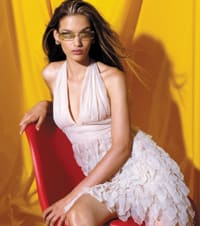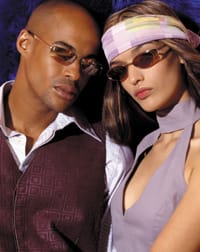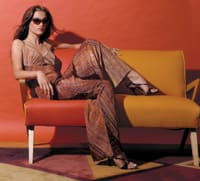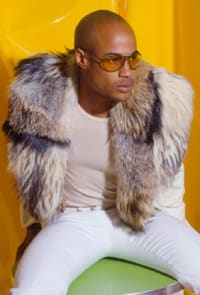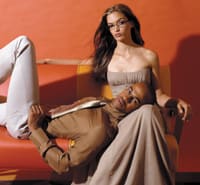The Ethnic Edge
The
Selling into
the young, urban look
By Marcy Bruch
Photography by Rick Guidotti
Styling by Stephano Zaousis - Hair and makeup by Joseph Boggess - Models: Alex/Wilhelmina and Kat/Ford
|
|
|
|
sitting pretty |
|
According to the U.S. Census Bureau, African-Americans and Hispanics are now virtually equal in number, with African-Americans totaling 12.5 percent of the population, and Hispanics jumping to 12.9 percent--which is a 58 percent increase over the past decade. And though Asian-Americans only account for 4.2 percent of the people in this country, that's almost double their presence compared to 1990. What's more, about 8.4 million Americans--or three percent of the population--define themselves as multiracial. The stats speak for themselves: Minorities are fast becoming the majority. Knowing that, it makes sense to cater to all segments of our country's rich ethnic diversity when it comes to selling eyewear.
AHEAD OF THE FASHION CURVE
While minority populations don't differ much from the mainstream, when it comes to eyewear preferences, dispensers report that younger African-Americans are more willing to buy eyewear that's bigger, bolder, and brighter. "My young African-American customers are definitely ahead of the curve when it comes to fashion trends," says Rebecca Cooper, owner of Omega Optical in Philadelphia. Knowing her 20- and 30-something urban clientele--which includes rising stars Eve and Jill Scott--is influenced by celebrities like Sean "P. Diddy" Combs, Mary J. Blige, and Lenny Kravitz, Cooper subscribes to Vibe, Essence, and InStyle magazines to see what celebrities are wearing. "I also tune into MTV regularly and never miss the Grammys or the Oscars," says Cooper.
|
|
|
|
retro chic |
In terms of hot looks, Cooper says that Combs owns the Chanel style 4012 in every color, so it's become his signature eyewear. "In fact, it's so popular here, I can't keep it in stock, so when my staff reorders it, they simply ask for the P. Diddy frame," she says.
Many of Cooper's African-American male customers even buy this frame style and have it made into ophthalmic eyewear. "The status brands like Chanel, Christian Dior, Versace, and Gucci sell just as well among our male clientele as they do among our female customers," she says.
While fitting frames on African-American females is no problem, for Tanya Carter, co-owner of Drs. Barnes and Carter in Montclair, N.J., fitting some African-American males is another matter. "A lot of the frames available have bridges and temples that are too small for their faces, so we have to adjust styles in order to get them to fit correctly," she says. Still, manufacturers are making an effort to address this market. The brands Essence, Diahann Carroll, Maurice Malone, and the recently launched Marc Ecko are some examples.
WHAT HISPANICS WANT
The upscale Latin market is also brand conscious, says Edward Beiner, owner of Purveyors of Fine Eyewear, two optical stores in Coconut Grove and Adventura, Fla. "Latino men prefer brands with a more macho connotation and they are less influenced by fashion trends. But Hispanic women are very fashion conscious," he says.
While Hispanic celebrities like Jennifer Lopez, Marc Anthony, and Enrique Iglesias have made a popular splash, there aren't as many licensed brands that target the Latino community exclusively. "Christina and Thalia are the only eyewear brands that I'm aware of," George Sobrino, owner of Universal Optical in Miami says.
What's the most popular frame material among his Latin clientele? "We always have a high demand for gold metal, but three-piece rimless mounts with slightly tinted lenses also sell well in the ophthalmic category," Beiner says.
Still, he points out that he caters to upper-middle class Hispanics in Miami, whose tastes--and pocketbooks--are very different than many Hispanics who live in California or New York City. "I'm dealing with the movers and shakers of Miami who want eyewear that's customized, fashion-forward, and reflects their position in society--which is why they'll pay anywhere from $250 to $600 for a frame," he says.
In Miami, Sobrino says his Hispanic customers, who are generally 40 years old and up with a modest income, are looking for frames that give them the most bang for their buck. "I sell metal frames here 10 to one over plastic, because my customers want frames that are durable and will hold up over the course of time."
|
|
|
laid-back style |
hot looks |
OFFER MORE ETHNIC P-O-P
Opticians who sell to the African-American and Hispanic markets suggest that suppliers could do more to support their sales efforts by utilizing multiracial models in their advertising campaigns and P-O-P materials. While Spanish-language advertisements are common in Miami, the models are not Hispanic. "I have certain brands that I do very well with here, but I could probably do even better with them if I had marketing materials featuring Hispanic models," Sobrino notes.
Although language is not an issue, the same lack of representative models occurs when it comes to marketing materials for African-American clientele, Cooper says. "If the manufacturers of designer eyewear analyzed their numbers and realized how much business comes from the African-American market, perhaps they would rethink how they are portraying their advertising."
|
|
|
|
on the town |
formal flair |




